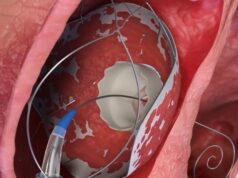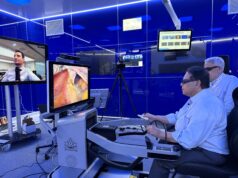This advertorial is sponsored by Medtronic
 Hypertension is a leading cause of heart attack, stroke and death, impacting more than 1.2 billion adults worldwide. For decades, the frontline treatment for this condition has been a varying combination of pharmacotherapy and lifestyle modifications, but a device-based treatment—renal denervation—has emerged as a potential option where current treatment options may not be enough. Crucially, as more evidence about the safety and efficacy of renal denervation emerges from clinical trials, new guidance in Europe raises the prospect that more patients could have this treatment available.
Hypertension is a leading cause of heart attack, stroke and death, impacting more than 1.2 billion adults worldwide. For decades, the frontline treatment for this condition has been a varying combination of pharmacotherapy and lifestyle modifications, but a device-based treatment—renal denervation—has emerged as a potential option where current treatment options may not be enough. Crucially, as more evidence about the safety and efficacy of renal denervation emerges from clinical trials, new guidance in Europe raises the prospect that more patients could have this treatment available.
Notably, the new and updated 2023 European Society of Hypertension (ESH) guidelines recommend the use of renal denervation among patients with apparent resistant hypertension as “additive or alternative to increasing medication”, as well as in patients with uncontrolled hypertension who are non-adherent or intolerant to antihypertensive drugs. Patients may be on fewer than three drugs at the time of their selection for the therapy.
“This is the first guideline that has changed the view on renal denervation,” says cardiologist Felix Mahfoud (Saarland University Hospital, Homburg, Germany), highlighting the significance of this development. For Konstantinos Tsioufis (University of Athens, Athens, Greece), a past president of ESH, this upgrade to the guidelines cements renal denervation as the “third pillar” for the treatment of hypertension. “It is not an alternative therapy to drugs, it is not a competitive strategy, it is something synergistic—an additional treatment,” he states. “This is the first time we have recommendations, and this publication will change the way of thinking. Now physicians will have one more tool in their hands to reduce high blood pressure.”
“We have plenty of hypertensive drugs, and we also know that lifestyle modification is able to lower blood pressure,” Mahfoud tells Cardiovascular News. “But, many patients do not adhere to it, and in many instances it is a lifelong therapy.”
Tsioufis similarly describes hypertension as the “most important contributor to cardiovascular mortality and morbidity” and highlights that there are a significant proportion of hypertensive adults whose blood pressure remains uncontrolled.
“There are many reasons for having low levels of controlled hypertension,” Tsioufis explains. “Among them, poor medication adherence is a major factor, so we need something to contribute to the blood pressure-lowering effect, irrespective of medication adherence.”
Mahfoud and Tsioufis have been among the leading investigators in studies assessing renal denervation, which has been shown to be capable of lowering blood pressure, as a complementary option to the existing treatments. The technique uses energy targeted to the renal nerves to modulate the sympathetic signalling between the kidneys and brain to reduce blood pressure. “We know that the sympathetic nervous system is involved in the development, progression and maintenance of hypertension and various other cardiovascular diseases,” explains Mahfoud as to why this area is the target of the treatment.
Much of the contemporary knowledge of the safety and efficacy of renal denervation comes from clinical study programmes including the SPYRAL HTN Global Clinical Programme, that has investigated the use of the Symplicity Spyral™ (Medtronic) system, and is the largest so far, having studied >4,000 patients including real-world data from the Global SYMPLICITY Registry. Additionally, over 25,000 patients have been treated worldwide with the Symplicity system.
To date the clinical programme has completed two randomised, sham-controlled trials, one involving the use of renal denervation in the presence of antihypertensive medications—the SPYRAL HTN-ON MED study—and another investigating the procedure in the absence of medications—the SPYRAL HTN-OFF MED Pivotal trial.
These have yielded important insights, with SPYRAL HTN-ON MED demonstrating durable reductions in ambulatory systolic blood pressure of -18.7mmHg at three years in patients receiving the renal denervation procedure. In SPYRAL HTN-OFF MED, a reduction of office systolic blood pressure of -9.2mmHg was seen at three months. Both trials have also demonstrated the robust safety profile of the device. Further trials are ongoing, including SPYRAL AFFIRM, which seeks to validate the long-term safety, efficacy and durability of the Symplicity procedure.

The clinical programme also includes the Global SYMPLICITY Registry, which is the largest individual source of information available in the renal denervation space, providing real word data from more than 3,400 patients enrolled to date. Mahfoud presented three-year insights from the registry at EuroPCR 2023 (16–19 May, Paris France), where he reported sustained and clinically meaningful blood pressure reductions of -16.7mmHg in office SBP in patients with uncontrolled hypertension independent of the antihypertensive medication regimen.
These studies are among the most recent clinical data to have contributed to the upgraded class of recommendation for renal denervation in the new and expanded 2023 ESH guidelines for the management of arterial hypertension. The latest guidelines, to which Tsioufis and Mahfoud both contributed, are intended to reflect expanded hypertension patient populations, as well as innovations in therapeutic strategies developed to treat uncontrolled hypertension—which includes renal denervation.
Careful patient selection sits at the heart of the guidelines, which set a clear benchmark as to when renal denervation can be considered. Patients who have uncontrolled blood pressure despite the use of antihypertensive drug combination therapy may be candidates for the procedure, or in instances where drug treatment elicits serious side effects and poor quality of life when estimated glomerular filtration rate (eGFR) is >40 ml/min/1.73m2, the guidelines state. Patients with resistant hypertension, if eGFR is >40 ml/min/1.73m2, may also be candidates for the therapy. Both of these scenarios carry a Class II recommendation.
Importantly, the guidelines state that selection of patients should be done as part of a shared decision-making process, noting that “understanding the patients’ perspective, exploring their preference and expectation, is crucial” prior to any procedure.
“We know from patient preference studies that roughly 30% of patients are interested in an intervention to lower their blood pressure, and this is something you should discuss with them,” says Mahfoud. “You can inform the patient about the potential risks and benefits of the procedure, and then, in a shared decision-making process, come to a decision over whether or not you pursue renal denervation or stay with conservative approaches to lower blood pressure.”
“Nowadays, we have to have patients at the centre of our decision,” adds Tsioufis. “Spend time with the patient to explain the risk associated with uncontrolled hypertension, the potential risk of an invasive procedure, even a minimally invasive procedure such as renal denervation, and the potential benefits. After this discussion, if the patient continues to prefer renal denervation, you should offer them this possibility.”
Furthermore, the guidelines state that the procedure should be carried out in experienced centres to guarantee appropriate selection of eligible patients, as well as the completeness of the procedure.
When it comes to device selection, operators can utilise systems that use different technologies to achieve renal denervation. The energy source used in the Medtronic system is radiofrequency energy and both Tsioufis and Mahfoud recognise that the benefits of radiofrequency renal denervation are supported by the largest amount of data coming from clinical trials.
“The radiofrequency technique is the most studied. It is the technique that introduced the concept of renal denervation, and up to now more than 4,000 patients have been included in the Spyral programme in the setting of clinical trials,” Tsioufis comments to Cardiovascular News. “It is the technology that has been used more extensively for research purposes. Now we have data to show that it is safe and effective.”
With these new guidelines in hand, physicians can now make this therapy available to their patients who may need an additional therapeutic option to control their blood pressure.










